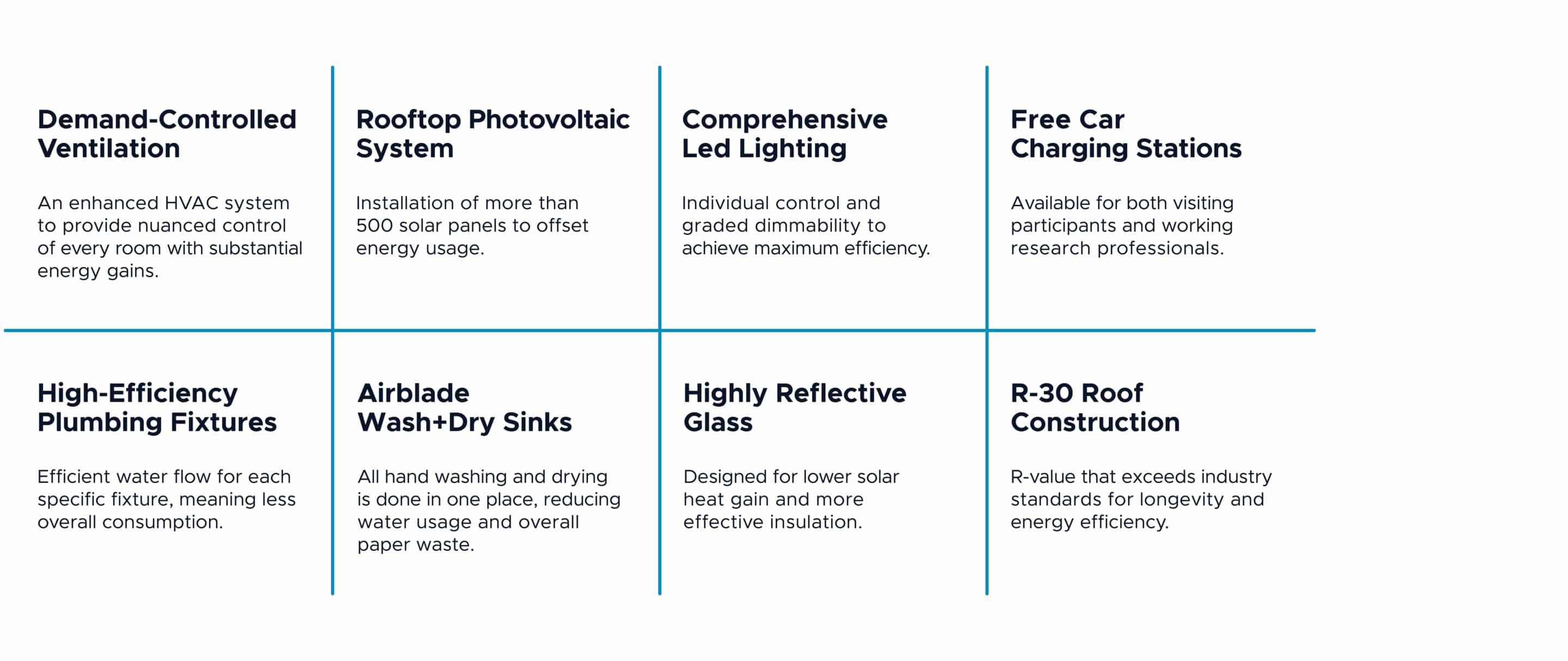At Dr. Vince Clinical Research we offer full-service Phase I-II trial execution that not only generates SMARTER FASTER DATA®, but does so through a building design that promotes greater overall wellness and long-term environmental sustainability.
In order to discover and support exciting new therapies for those in need, clinical trials need to be supported by the most powerful and purpose-built buildings available. That said, many research facilities are poorly retrofitted or highly restricted by a limited budget. Consequently, their design, construction and resource usage give only fleeting attention to their environmental impact. In fact, healthcare pollution is on the rise in every sector, responsible for 10% of nationwide greenhouse gas emissions and air pollutants (1), as well as 4% of pollutants around the world (2).
So, how did Dr. Vince Clinical Research (DVCR) make the right investments and create a functionally advanced and eco-friendly facility?
It Started With a Vision
What is now one of the country’s most cutting-edge research facilities was born from a desire to create the ideal setting for clinical trials — one that offers the latest technology while respecting its impact on the environment. This end goal is what fueled Dr. Bradley Vince’s original vision of a world-class facility. Though the building incorporated a long-lasting brick frame, converting such a space into a first-class research center presented a number of challenges. For Randy Benbrook, architectural project manager of Bell/Knott & Associates, this meant working in tandem with DVCR leadership to answer a host of targeted questions as early as the initial design:
- How do we reduce the carbon footprint of the structure?
- Which green building strategies will make a real impact on sustainability?
- How can we consider the life cycle and long-term performance of the building?
The answers to these questions made for a complete transformation. The DVCR team wanted a facility that was first class on every level. It needed to be technologically advanced and functionally sustainable while still feeling inviting to those participating in clinical trials and offering something beautiful to the community. These standards are the product of Dr. Vince’s overall vision for an organization that leads the clinical research industry toward a more sustainable future:

Construction proceeded using only high-quality, sustainable materials, such as thick-grade aluminum siding, limestone paneling, highly reflective glass, and low-impact landscaping.
Guiding DVCR through this entire process were the sustainability assessment experts at Green Building Initiative (GBI). There are multiple routes an organization can take to pursue sustainable design and construction, but GBI’s Green Globes Building Certification was the best avenue for achieving Dr. Vince’s vision of an eco-friendly and awe-inspiring research center.
Why Green Globes Certification?
Green Globes certifications are rooted in science, assessing structures based on their environmental sustainability, health and wellness standards, and long-term resilience. Most importantly, however, GBI forms an active partnership that follows organizations like DVCR from beginning to end in order to ensure their sustainability decisions are meaningful, measurable and logically consistent. In this case, Dr. Vince and Randy Benbrook partnered early on with David Johnson, Green Globes assessor, and Sara Rademacher, GBI’s vice president of programs and services, to create a proactive plan that considered every possible challenge:

DVCR is designed for high-quality clinical research. However, delivering on such a promise also requires a welcoming residential area and a space devoted to high-tech pharmaceuticals. Each of these specific uses presents its own unique challenges regarding eco-friendly construction and valuable opportunities for more sustainable building features, which is why DVCR’s guided preliminary review with David was so critical to future success.

Such initial assistance, on-call guidance and consistent on-site assessments helped DVCR become Two Green Globes Certified. In doing so, DVCR not only created a more sustainable space for research, but also a clinical setting that is both a welcoming space for its volunteers and an inspiration to its employees. This is a significant milestone for any organization, and it is especially rare for sites conducting clinical research.

A Better Facility Is Born
The DVCR Center is a standout research facility by every metric. Everything from initial planning to HVAC optimization was executed in collaboration with GBI professionals and incorporated the most sustainable, high-quality materials. What’s more, each area of the facility contains a host of integrations and technologies designed to achieve greater sustainability:
These features represent substantial upfront investments, and many were personally inspected and tested by members of the DVCR leadership team as they were incorporated into the building design. At DVCR, we believe that making tough decisions NOW is the only way to ensure the quality and sustainability of clinical trials both today and tomorrow. Every investment in our cutting-edge research center represents not only the potential for long-term cost and resource savings but also the opportunity to affect more significant change for clinical studies and the environment as a whole. As such, we have created one of the country’s most advanced and sustainable clinical research centers to provide you with SMARTER FASTER DATA® and inspire the industry to keep moving forward.

Reimagine Clinical Research
Dr. Vince Clinical Research is reimagining the future of clinical trial execution, and our facility reflects that in both the quality of its construction and the sustainability of its design. We have partnered with GBI to design and construct one of the most advanced and environmentally conscious research facilities in the United States. In doing so, we hope to not only support more life-changing therapies in their journey to market, but also to set an example for what other CROs can achieve in terms of green design and wellness standards.
____________________________________________________________________________________________________________________________________________________________________
References
1 Kelly, S. Health sector causes 10% of greenhouse gas emissions, report finds. Published 19 Sept. 2022.
2 Eckelman, M., Huang, K., Lagasse, R., et al. Health Care Pollution And Public Health Damage In The United States: An Update. Health Affairs, 39(12). Published Dec. 2020.


